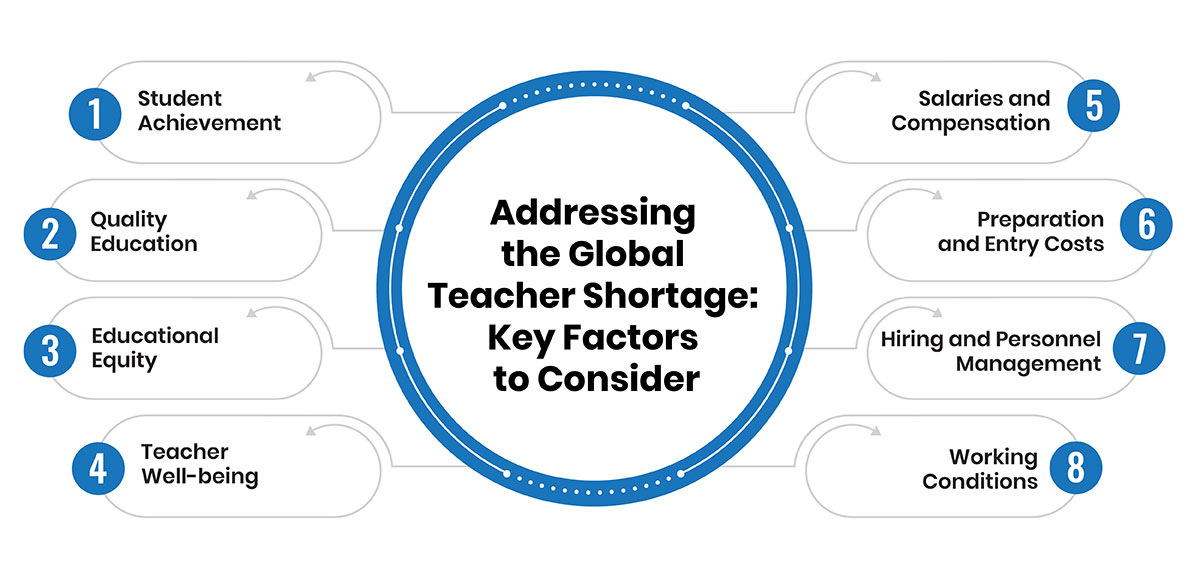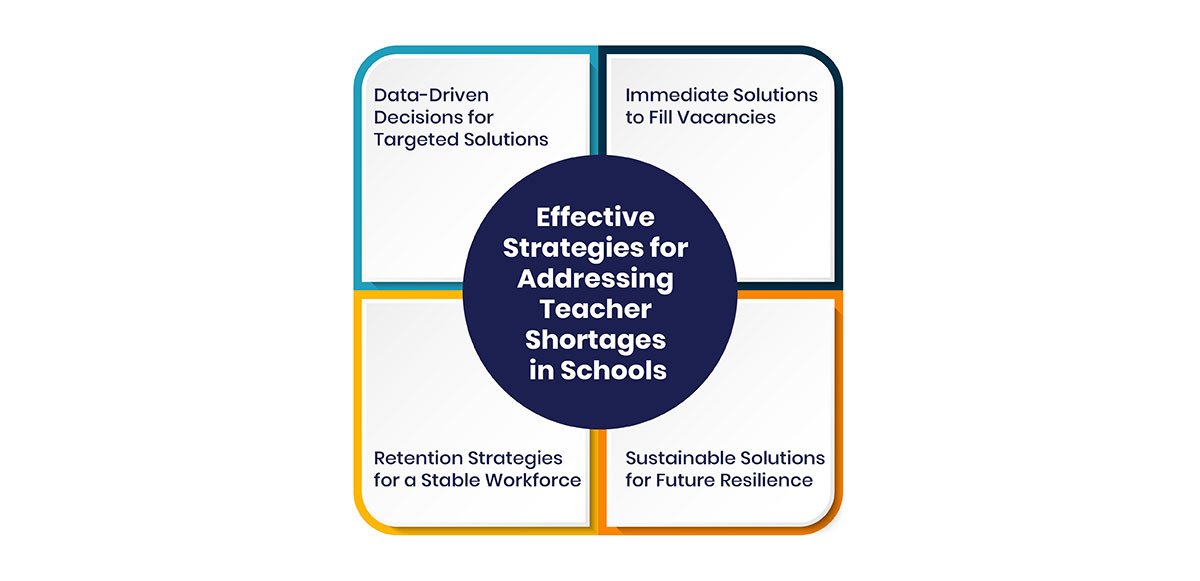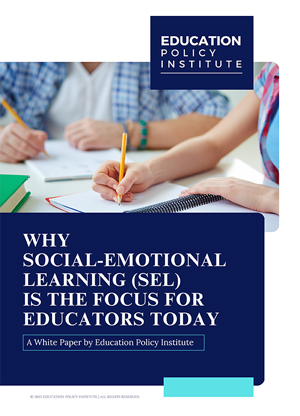The shortage of teachers has become a pressing issue for educational systems worldwide, with schools increasingly challenged to fill vacancies and retain skilled educators. High turnover, limited new entrants to the profession, and factors such as inadequate pay and job pressures have contributed to this ongoing problem. For students, these shortages often mean larger class sizes, reduced individualized support, and a decline in overall education quality, particularly in under-resourced areas where stability is most needed.
To address this, schools and policymakers are seeking sustainable solutions that extend beyond temporary hiring measures. Strategies like encouraging local community members to join the teaching profession and using data-driven recruitment approaches tailored to specific needs are showing promise. By focusing on retention, improving job satisfaction, and fostering a supportive environment, educational leaders aim to create a resilient workforce capable of meeting the evolving demands of today’s classrooms.
The Global Teacher Shortage Crisis
The educator shortage represents a significant challenge facing educational systems globally, as institutions grapple with the difficulty of recruiting and retaining qualified professionals, especially in essential areas such as elementary education and special education. Key factors driving this shortage include decreased enrollment in teacher preparation programs and high turnover rates. According to the National Education Association (NEA), enrollment in teacher training has dropped by 35% in the last decade. Low compensation, excessive workload, and difficult working conditions further fuel this attrition, which directly impacts students by increasing class sizes, limiting personalized instruction, and diminishing overall education quality, particularly in low-resource schools.
Low pay is a major deterrent for both aspiring and current educators. Beyond compensation, the heavy workload also drives many away. As stated by the NEA, teachers juggle lesson planning, grading, extracurricular activities, and professional development, leading to burnout, with 90% of teachers labeling it a "serious" problem, and 67% viewing it as “very serious”. Moreover, overcrowded classrooms, insufficient resources, and limited administrative support exacerbate job dissatisfaction, further weakening teacher retention.
The teacher shortage crisis is expected to worsen. The United Nations has projected a critical need for teachers worldwide, predicting that 44 million educators will be required by 2030 to meet global education targets. High attrition rates among teachers have nearly doubled globally in recent years, with a significant number leaving the profession within five years of starting their careers, according to reports from the Organisation for Economic Co-operation and Development (OECD) and the Learning Policy Institute. To combat the worsening teacher shortage, immediate actions are essential, focusing on enhancing teacher training, improving working conditions, and providing competitive salaries. Without these changes, achieving global education targets will be increasingly challenging.
Addressing the Global Teacher Shortage: Key Factors to Consider
The ongoing teacher shortage is a serious concern for educational systems around the globe, creating challenges in recruiting and retaining qualified educators. Below are the critical factors influencing this crisis:

-
1. Student Achievement
The lack of qualified teachers significantly impacts student achievement. Research from the Learning Policy Institute indicates that districts with high levels of inexperienced teachers often experience lower academic performance, increased dropout rates, and poorer attendance. This issue is particularly pronounced in low-income areas where students already face significant disadvantages. -
2. Quality Education
A robust education system relies on a well-prepared, qualified, and experienced teaching workforce. Teacher shortages frequently force schools to hire underqualified individuals, adversely affecting the quality of education. High workloads, limited resources, and a lack of personalized attention contribute to declining educational standards, making it crucial to address the shortage for improved student outcomes. -
3. Educational Equity
The teacher shortage disproportionately affects underserved and low-income communities, perpetuating educational inequity. These areas tend to have a higher concentration of underqualified teachers and struggle to retain experienced educators, exacerbating the opportunity gap between students from different socioeconomic backgrounds. -
4. Teacher Well-being
Elevated stress levels, increased workloads, and insufficient resources contribute to burnout among educators, leading to high turnover rates. Teachers who remain in the profession often feel overwhelmed by large class sizes and demanding responsibilities, which can negatively affect their mental health and job satisfaction. A stable teaching workforce is essential for fostering a supportive environment where educators can thrive and, in turn, better serve their students. -
5. Salaries and Compensation
Teacher salaries play a vital role in the supply and distribution of educators across districts. Evidence suggests that lower wages increase teacher attrition. For instance, a significant percentage of teachers who left the profession indicated that a salary increase would be a key factor in their decision to return. -
6. Preparation and Entry Costs
Effective preparation significantly enhances teacher effectiveness and retention. However, the rising costs of higher education and concerns about student loan debt deter many prospective teachers. Programs that offer financial aid, scholarships, and support can help recruit and retain educators, particularly those familiar with the communities they serve. -
7. Hiring and Personnel Management
The practices surrounding teacher hiring and support greatly influence retention rates. Timely hiring and a robust hiring process improve teacher quality and satisfaction. Support for mobile teachers and retention of retirement benefits, is crucial for retaining educators. -
8. Working Conditions
The working environment significantly affects teachers' decisions to stay in or leave the profession. Factors such as administrative support, opportunities for collaboration, and accountability systems all play a role. Furthermore, schools with adequate resources and a safe learning environment can maintain teacher satisfaction and retention.
Effective Strategies for Addressing Teacher Shortages in Schools
Schools are addressing teacher shortages with both immediate fixes and long-term solutions to ensure educational quality. Here are few strategies to consider:

1. Immediate Solutions to Fill Vacancies
-
Rehiring Retired Educators:
Retired teachers provide valuable expertise, stability, and familiarity with school curricula and routines. However, some retired educators may be less familiar with new educational standards and technologies, which could limit the effectiveness of this solution if used as a sole approach. -
Emergency Certification Programs:
Schools often turn to emergency certification to quickly fill high-need positions by allowing individuals without traditional teaching credentials to begin teaching. This fast-track program covers basic training and testing, but due to its brief nature, participants may lack comprehensive preparation, risking quality in teaching practices. -
Classroom Consolidation:
To manage vacancies, schools sometimes combine classes, placing a larger number of students under a single teacher. While this can maximize existing resources, it can also strain teachers and reduce individual attention for students, impacting learning outcomes.
2. Sustainable Solutions for Future Resilience
-
Expanding Hiring Pools by Removing Geographic Restrictions:
By broadening hiring requirements to include remote teaching options, schools can attract qualified candidates from beyond local boundaries, a significant benefit for remote and underserved areas. -
Implementing Live Virtual Teaching with Classroom Coaches:
Remote teaching supported by on-site classroom coaches provides students with high-quality instruction while allowing in-person coaches to manage classroom dynamics. This blended approach reduces costs and teacher workload while providing a valuable mix of personal and digital instruction. -
Offering Flexible Scheduling for Teachers:
Flexibility in work hours allows teachers to set their schedules, promoting better work-life balance and reducing burnout. This flexibility is also an attractive feature for potential candidates, encouraging more individuals to consider teaching careers in less traditional formats.
3. Retention Strategies for a Stable Workforce
-
Mentorship and Professional Development Programs:
Retaining experienced teachers is crucial. Mentorship provides new teachers with guidance, reducing the risk of burnout and early departure from the profession. Professional development programs tailored to individual strengths encourage growth and maintain motivation among educators, building a more engaged workforce. -
Blended Learning Options for Teacher Training:
Blended learning for professional development allows teachers to customize their training experiences, choosing opportunities aligned with their needs and schedules. This autonomy increases job satisfaction, leading to improved retention rates. -
Supporting Teacher Wellness and Recognition:
Implementing wellness programs and formal recognition helps prevent burnout, while offering mental health resources, flexible work options, and public recognition contributes to a positive work environment.
4. Data-Driven Decisions for Targeted Solutions
-
Workforce Analytics for Attrition Prevention:
Using data tools to track teacher satisfaction and turnover risk enables schools to identify potential issues early, allowing for timely intervention and reducing attrition rates. -
Strategic Staffing and Resource Allocation:
Analyzing workforce trends helps administrators allocate resources where they’re needed most, focusing recruitment and retention efforts on high-need areas like special education. -
Engaging the Community and Offering Financial Flexibility:
Community partnerships enhance support for teachers, while financial wellness options, like flexible access to wages, help improve retention. Flexibility in pay reduces financial stress and increases job satisfaction, contributing to long-term workforce stability.
Conclusion
To resolve teacher shortages effectively, educational institutions need both immediate actions and deeper reforms that address underlying challenges in the profession. Through the ongoing efforts, educational systems can build resilience, adapting to future needs and maintaining strong learning outcomes for students.





